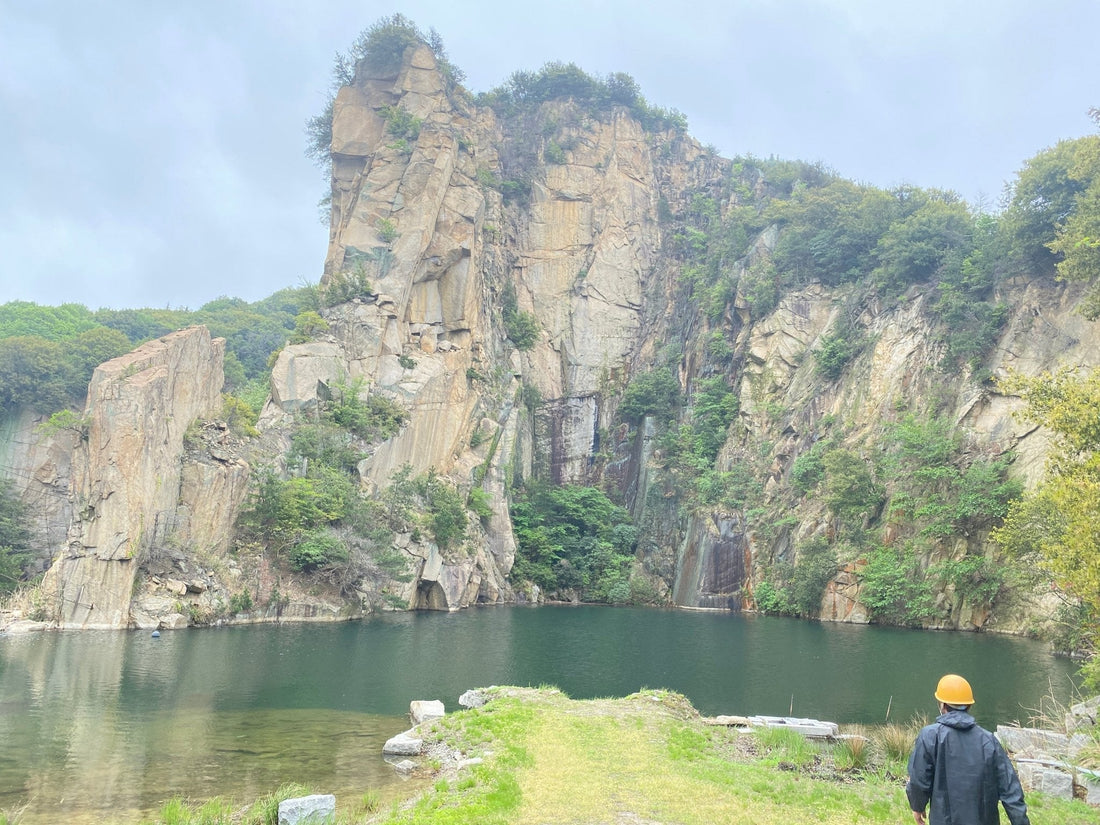
Quarry visit report 2025 No.1 Kitagi Island
Share
Kitagi Island — The Stone Island Behind Japan’s Iconic Architecture


Kitagi Island, part of Kasaoka City in Okayama Prefecture, is one of the Kasaoka Islands in the Seto Inland Sea. Though small, covering only about 7.5 km², it has long been known as the “Stone Island.” The granite quarried here is called Kitagi Stone, a material that played a central role in shaping Japan’s modern architecture.
Kitagi Stone is fine-grained, uniform, and calm in its gray tone. It is both strong and durable, yet highly workable, making it suitable for a wide range of uses such as castle walls, bridges, embankments, monuments, and gravestones.
History of Kitagi Stone Quarrying
Geological Age of Kitagi Stone
Kitagi Stone is believed to have formed during the Late Cretaceous period, about 85 to 100 million years ago.
This was a time of large-scale granite activity across western Japan.
Kitagi granite belongs to the Setouchi Granite Belt, together with:
Hiroshima’s renowned granites, such as Aji Stone and Oshima Stone
Other granite groups in Ehime, Kagawa, and Okayama
Its fine grain, durability, and refined beauty later made it one of Japan’s most prestigious and widely used granites.
Ancient to Medieval Periods
The exact origins of Kitagi Stone quarrying are unclear, but stone use in the Bisan Seto islands of Okayama Prefecture dates back to ancient times.
Archaeological evidence suggests Kitagi granite was used in stone walls and Buddhist statues.
Edo Period (1600s–1800s)
Thanks to its location along the Seto Inland Sea shipping routes, Kitagi Island became an important hub for stone transport.
Full-scale quarrying developed, and Kitagi Stone was widely distributed for castle walls and temple architecture.
It is said to have been used in the reconstruction of Osaka Castle.
Meiji Period (Late 1800s–Early 1900s)
With Japan’s modernization, demand for granite surged. Numerous quarries opened on Kitagi Island, employing thousands of stonemasons and workers.
Representative uses include:
・Bank of Japan Head Office (1896) Link
・Bank of Japan Osaka Branch (1903)
・Nihonbashi Bridge (1911)
・National Diet Building (1936, partly)
Showa Era (1900s)
During Japan’s rapid economic growth, Kitagi Stone was used extensively in ports, seawalls, monuments, and gravestones.
It became widely known as a prestigious Mikage Stone brand.
At its peak, most residents of Kitagi Island worked in the stone industry, and the entire island became known as a “stone town.”
1990s to the 2020s
With domestic demand declining and overseas low-cost granite imports increasing, the number of active quarries fell.
Even today, however, several companies remain active, and Kitagi Stone continues to be highly valued, particularly for restoration and repair of national heritage buildings.
In recent years, quarry sites have also been promoted as tourist attractions, with guided tours and stone museums highlighting their cultural and historical importance.
My Visit in April 2025
I visited Kitagi Island in April 2025 as part of a study session organized by my stone industry partners. From Kasaoka Port, we boarded a small cruiser and crossed roughly 15 kilometers of calm Seto Inland Sea waters before reaching the island. Approaching the shore, the scale of the former quarries came into view, revealing the source of stone that once built Japan’s most prestigious landmarks.



Standing there, I realized once again that Kitagi Stone was the foundation for the National Diet Building, the Bank of Japan Head Office, and Nihonbashi Bridge. This small island supplied the granite that became the backbone of Japan’s national architecture.
Walking Through the Quarry
The first sight upon arrival was the towering quarry cliffs carved into the mountainside. Layer after layer of vertical cuts formed a dramatic landscape where human labor reshaped the island. Centuries ago, hundreds of stoneworkers toiled here with chisels and hammers, cutting blocks that would travel across Japan.

Today, silence dominates, but the tool marks remain vivid on the rock faces. Unshipped granite blocks still lie scattered on the ground, each one a piece of potential history that might have stood as part of a bridge or building had it been delivered. From the highlands, the panoramic view of the Seto Inland Sea contrasting with the gray granite quarry creates an unforgettable scene.
Kitagi Stone and Japan’s Architectural Heritage
Standing at the quarry, it is clear that Kitagi Stone is not just a material but a historic resource that shaped Japan’s cultural identity. The solemn walls of the National Diet Building, the solid design of the Bank of Japan, and the elegance of Nihonbashi Bridge all exist thanks to the granite taken from this island.

Conclusion
The Kitagi Stone quarries are both a historic site and a breathtaking viewpoint. In recent years, guided tours have been offered, allowing visitors to explore the quarry up close. If you are interested in stone culture, architecture, or simply stunning landscapes, consider adding Kitagi Island to your itinerary when traveling in Japan.
Visiting the Bank of Japan Head Office - A Granite Monument of the Late 19th Century
Kitagi Stone Gray Gorinto Small Granite Japanese Garden Ornament Statue
